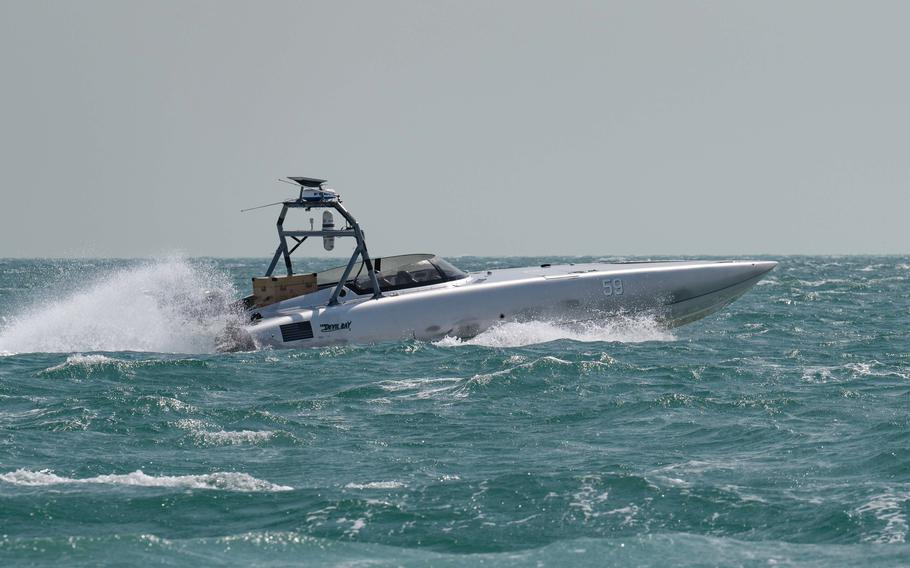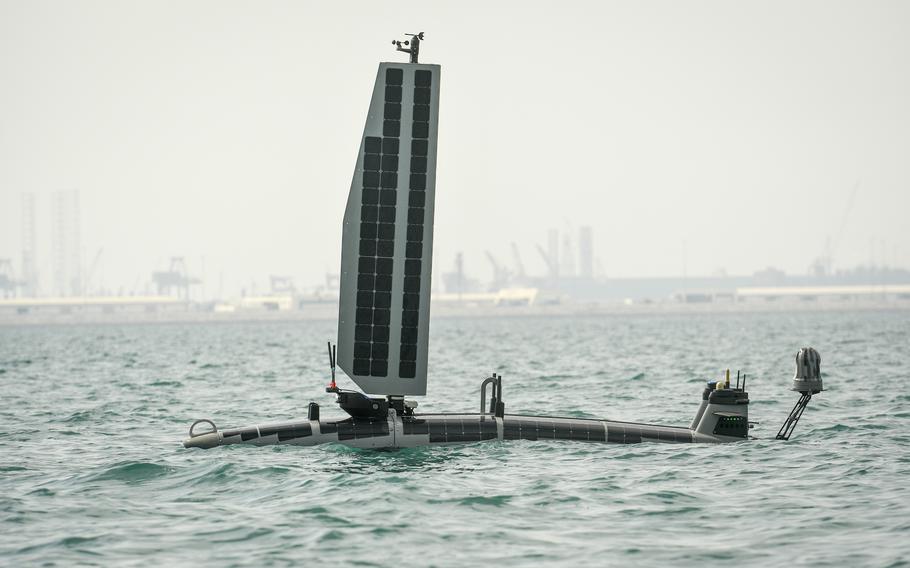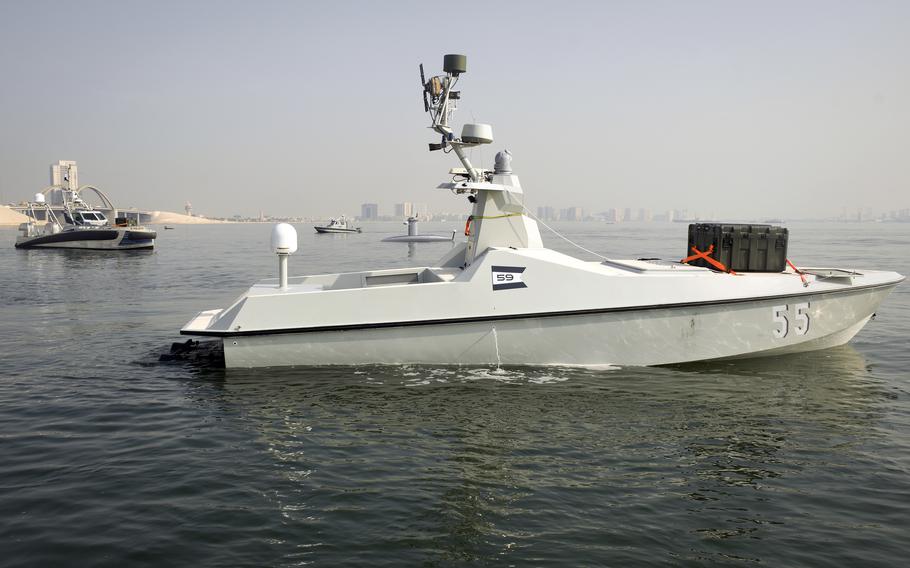
A MARTAC T-38 Devil Ray unmanned surface vehicle operates in the Arabian Gulf, Oct. 26, 2023. According to a military official, the U.S. Navy has changed the focus of its Middle East drone boat effort after not reaching its goal of assembling a fleet of 100 unmanned surface vessels. (Jacob Vernier/U.S. Navy)
The U.S. Navy’s much-touted goal of a regional fleet of 100 unmanned surface vessels in the Middle East fell so short of expectations that the service has scrapped the notion of a numerical target for the program, according to a military official.
The focus was switched “from a firm number to an operational capability,” the official, who has knowledge of the program, said Wednesday on condition of anonymity in order to speak on sensitive matters.
By the end of last summer, the Navy said it had about 50 such vessels that it considered part of the regional fleet, of which the U.S. contributed about 20. But since last fall, naval officials have been loath to speak about the issue.
The aim was to have the 100 drone boats patrolling Middle Eastern waters by the end of the summer of 2023, U.S. military officials said last year. The unmanned craft would have been provided primarily by regional allies.
They would have collected information to be shared among the U.S. and its allies in the Middle East, following the example of the Navy’s tech unit Task Force 59, which since 2021 has tested and operated unmanned surface ships in the region.

The unmanned vessel Ocean Aero Triton cruises through international waters between Naval Support Activity Bahrain and Iran on Nov. 30, 2022, as part of a naval exercise. The U.S. Navy's goal of having a fleet of 100 unmanned surface vessels in the Middle East remains unfulfilled. (J.P. Lawrence/Stars and Stripes)
But the Navy was overly keen to announce a fleet with an eye-catching number of unmanned surface vessels and didn’t factor in their Persian Gulf allies’ concerns, according to analysts.
“The countries are interested in maybe pursuing these as individual efforts, but they’re not necessarily looking to do it as part of that cooperative activity that the Task Force 59 guys were leading,” said Bryan Clark, a senior fellow at the Washington-based Hudson Institute.
Countries such as Saudi Arabia and the United Arab Emirates have expressed a willingness to invest in naval surveillance drones and have the resources to do so, experts said.
But these nations are sometimes competitors and have been hesitant to join an effort involving the sharing of sensitive information, said Clark, an analyst on naval operations and autonomous systems who spoke to Gulf and 5th Fleet officials.
Arab leaders in the Gulf questioned the regional fleet idea last year and have been reluctant to share radar data with each other this year as part of a U.S.-backed initiative to cooperate on air defense, regional news site Al-Monitor reported last week.
In a November interview, Capt. Colin Corridan, head of Task Force 59, cited difficulties in persuading other navies to make a “cultural leap” toward unmanned naval vessels.
“It’s not going to happen immediately,” Corridan said, adding that he was not keeping track of the numbers.

Unmanned ships with green boxes containing aerial drones prowl the waters near Naval Support Activity Bahrain on Dec. 1, 2022, as part of an exercise that was the first test for 10 systems by the U.S. 5th Fleet. The U.S. Navy failed to meet its much-touted goal of putting together a fleet of 100 drone boats in the Middle East. (J.P. Lawrence/Stars and Stripes)
After saying in September that the project was on a “trajectory toward meeting” the goal, U.S. 5th Fleet spokesman Cmdr. Rick Chernitzer responded to an update request in February by saying there was “nothing new to share ... on the regional fleet.”
This week, Chernitzer declined to answer questions on the status of the initiative and could not specify a country that had joined, citing sensitivities of the nations involved. He issued a statement saying that 5th Fleet is focused on “delivering new capabilities.”
The failure to meet the expectation of having a 100-drone Middle East fleet is an example of the Navy’s hype about unmanned systems outpacing its abilities, experts said.
“The problem there is if you don’t hit that mark, you lose credibility,” said Joe Buccino, a former U.S. Central Command spokesman.
The numerical target “was always a bit of an aspiration,” added Buccino, who as CENTCOM’s chief spokesman until 2023 spearheaded much of the initial messaging about the initiative.
And the goalposts have been shifting on the program since its inception, Buccino said, noting that the deadline set by the Navy changed at least three times.
While the conflict between Israel and Hamas has taken up much of CENTCOM’s focus in the region, Buccino said the drone fleet plan was already behind schedule on Oct. 7, when a Hamas terrorist attack on Israel started the war.
According to Clark, the Navy’s attention in the Middle East is now geared toward more combat-focused operations that are not part of its previous shared regional fleet concept.
Already, U.S. naval forces in the region have launched missiles from drone boats, and there is a new unit, Task Group 59.1, that can take robots into combat operations.
Rand Corp. analyst Michael Bohnert said there was no need for the Navy to try to rush its drone boat plans into reality.
In light of how new the field is and how much is being learned about the use of unmanned naval weapons from the war in Ukraine, the U.S. should give itself a few years of leeway for development, he said.
“Everyone is reviewing their uncrewed portfolios,” Bohnert said. “Given it is literally training day for the world, any continued forward progress is fine for now.”